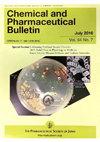缩醛与三烷基硅酰氯(R3SiCl)反应中的意外惊喜:芳香无环缩醛的有效脱保护。
IF 1.3
4区 医学
Q4 CHEMISTRY, MEDICINAL
引用次数: 0
摘要
缩醛与三烷基硅酰氯(R3SiCl)反应导致缩醛基团脱保护,生成相应的羰基化合物。值得注意的是,芳香族二烷基缩醛能以较高的收率生成相应的亲本芳香族醛和酮。反应条件非常温和,允许许多酸不稳定的官能团存活而没有任何问题。此外,我们通过核磁共振研究阐明了反应机理。本文章由计算机程序翻译,如有差异,请以英文原文为准。
Unexpected Surprise in the Reactions of Acetals and Trialkylsilyl Chloride (R3SiCl): Efficient Deprotection of Aromatic Acyclic Acetals.
The reaction of acetals with trialkylsilyl chloride (R3SiCl) leads to the deprotection of the acetal group, resulting in the corresponding carbonyl compounds. Notably, aromatic dialkyl acetals yield the corresponding parent aromatic aldehydes and ketones in good yields. The reaction conditions are very mild, allowing many acid-labile functional groups to survive without any problems. Additionally, we clarified the reaction mechanism through an NMR study.
求助全文
通过发布文献求助,成功后即可免费获取论文全文。
去求助
来源期刊
CiteScore
3.20
自引率
5.90%
发文量
132
审稿时长
1.7 months
期刊介绍:
The CPB covers various chemical topics in the pharmaceutical and health sciences fields dealing with biologically active compounds, natural products, and medicines, while BPB deals with a wide range of biological topics in the pharmaceutical and health sciences fields including scientific research from basic to clinical studies. For details of their respective scopes, please refer to the submission topic categories below.
Topics: Organic chemistry
In silico science
Inorganic chemistry
Pharmacognosy
Health statistics
Forensic science
Biochemistry
Pharmacology
Pharmaceutical care and science
Medicinal chemistry
Analytical chemistry
Physical pharmacy
Natural product chemistry
Toxicology
Environmental science
Molecular and cellular biology
Biopharmacy and pharmacokinetics
Pharmaceutical education
Chemical biology
Physical chemistry
Pharmaceutical engineering
Epidemiology
Hygiene
Regulatory science
Immunology and microbiology
Clinical pharmacy
Miscellaneous.

 求助内容:
求助内容: 应助结果提醒方式:
应助结果提醒方式:


